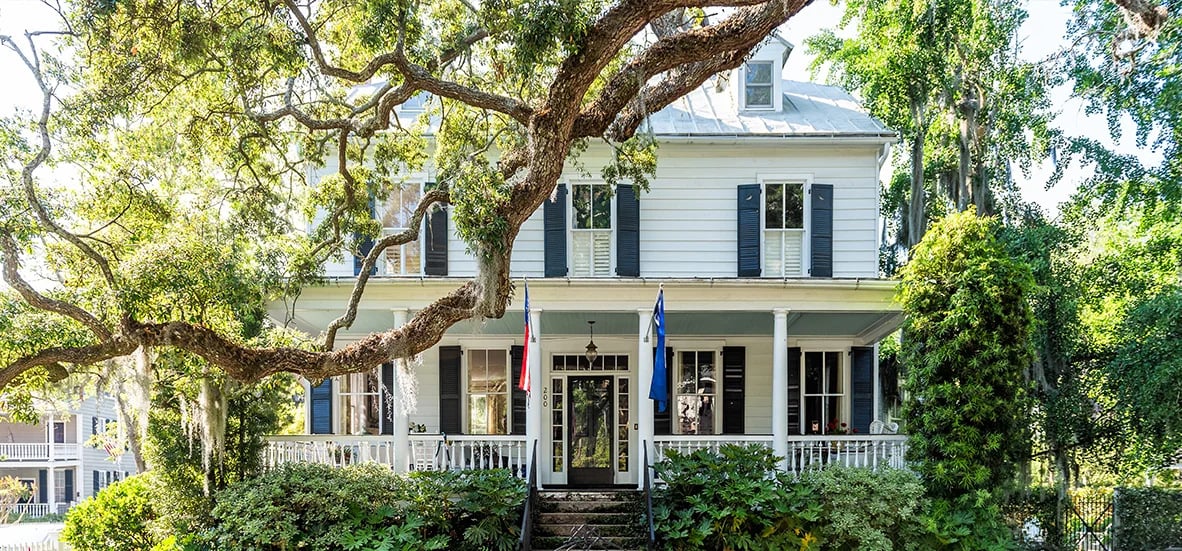Historic homes have specific roofing needs that vary from modern properties. When renovating a historic property, often times roofers will try to maintain the same material composition, or use modern technology and materials if it will be beneficial to the property. This can help preserve the original look of these homes while also providing them with improved protection from the elements. Find out more about some of the most commonly used roofing materials for historic homes.
Historic Wood Shingle Roofing
Wood shingle roofs give historic homes a beautiful, rustic appearance. This type of material was used often on homes built during the past few centuries, especially in rural areas where fires were a lesser concern. The type of wood used for historic roofs often varies based on the local climate — as roofers used shingles made from trees local to the area. Wood roofs are prone to specific types of damage or wear and tear, such as buckling or rot from moisture. This is why it is important to know what wood shingle type works best for your area, as this can lower your risk of damage. In the South, cypress and cedar are among the more common types of wood shingles used on roofs. This is because these wood types can withstand the hot, humid climate and offer a small amount of weather resistance.
Regular maintenance on historic homes with wood shingle roofs help ensure that these roofs are able to protect historic home interiors. Modern roofers will still occasionally replace wood shingles for repairs or renovations. However, most professionals recommend the combination of historical and modern alternatives to wood shake, like asphalt or metal shake shingles from CertainTeed. Landmark Premium, Presidential Shake, and Matterhorn Metal Roofing Shake shingles replicate the shade, texture, and rustic appearance of natural wood. However, these materials offer a longevity and fire resistance that traditional wood shingles lack.
Historic Metal Roofing
Metal roofing is often seen on historic homes from the 1800s. The exact type of metal used for these roofs varied, and included sheet lead, copper, tin alloys or tin plating, zinc, and sheet metal shingles. In the South, particularly North Carolina, sheet lead is more commonly used for fabrication of plumbing vent stack flashings rather than as a roofing material. Historic homes with metal roofs have added protection from fire, although they can become corroded over time. These roofs offer significant benefits for older homes, including a long life expectancy, a high amount of durability, less maintenance and improved energy efficiency that helps keep home interiors cooler.
When they need to be restored, homeowners have options available to lower the risk of rust and corrosion that is commonly seen with metal roofing. Galvanization is often a recommendation by professional roofing companies.
Historic Slate Roofing
Slate roofs are known for their lengthy lifespans — making it common to see historic homes in the U.S. with their original slate shingles. While slate has been found on buildings from the mid-1600s, this material wasn’t used often until the 1800s. Slate roofs offer a winning combination of decorative charm and durability, which made them a common choice for homes built in the 19th and 20th centuries.
Slate roofing on historic homes provides peace of mind and visual appeal. This type of material has a classic appearance that doesn’t go out of style, no matter what century it is, and it’s highly resistant to fire, inclement weather, and other hazards that can threaten a historic home’s condition. Slate shingles are available in a wide range of colors, so that homeowners can find the right tone to match their original roof. Slate roofs on historic homes can easily last for more than 100 years with proper maintenance.
Historic Clay Tile Roofing
The use of clay tile for roofs on historic homes in the U.S. dates back to the 1600s, thanks to their stylish appearance and fire-resistant qualities. Clay tiles come in different styles, including flat tiles, interlocking tiles, and Roman tiles, and are available in a variety of colors. Since clay tiles are also made to match several types of architectural styles, this makes renovations and repairs easy as roofers can easily match new clay tiles to the originals.
Clay tiles provide older homes with notable benefits, such as better resistance to severe weather, including gusty conditions that could tear off less durable tiles. This type of roof also helps lower the risk of extensive and costly fire damage to historic homes. Clay tiles can withstand wear and tear from sun exposure, which helps them maintain their color over the years rather than fading or becoming brittle. With their durability, aesthetic appeal and long lifespan, clay tiles offer great value for roof restoration on historic homes.
If your historic home’s roof uses wood, metal, slate, or clay tile shingles, you should take special care to keep your roof in good shape. If you are looking to renovate or repair your historic roof, you should only work with professional roofing companies who specialize in historic roofing. These professionals will be able to repair or renovate your roof while maintaining the original character of the home that other roofers do not understand.
At Pickard Roofing, we think Design. Craft. Renew. We are experienced in all types of roofing systems- and provide the right roofing design and selective craftsmanship for renewing our customer’s assets. We invite sustainable building customers to give us a call for your free evaluation. For over 90 years Pickard Roofing Company has installed countless metal, tile, slate, TPO, EPDM, and all types of shingle roofing in the Triangle. Our services including residential, commercial, custom architectural metal fabrication, and historical renovation.







